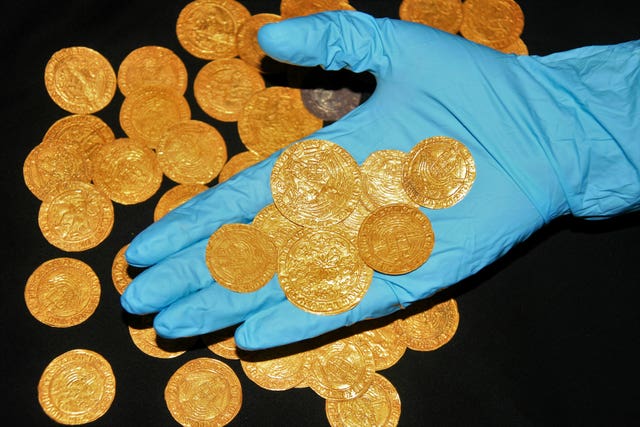
A “miraculous” find of gold coins dating from the late 15th century was discovered by a family weeding their garden.
Sixty three gold coins and one silver coin thought to have been deposited around the year 1540 were found in the New Forest.
 Tudor coins found in the New Forest (The Trustees of the British Museum/PA)
Tudor coins found in the New Forest (The Trustees of the British Museum/PA)
The family, who have asked to remain anonymous, had been pulling weeds out of their garden, the British Museum - which registered the find - says.
Dating from the late 15th to early 16th century, the hoard includes four coins from Henry VIII’s reign, unusually featuring the initials of his wives Catherine of Aragon, Anne Boleyn and Jane Seymour.
John Naylor, from the Ashmolean Museum, said the hoard was likely to have been hidden either by a wealthy merchant or clergy fearful of Henry VIII during the Dissolution of the Monasteries, in which he took control of many of the religious community’s assets.
Mr Naylor said: “It is likely that there are two options of who may have buried a hoard like this. It could be a merchant’s hoard. There was a lot of wealth in that part of the world. The wool trade was still very important. The New Forest is also very close to the coast and very close to some major ports so it is entirely possible it could be someone involved in maritime trade.
“On the other hand though, you also have this period in the late 1530s and 1540s where you have the Dissolution of the Monasteries. We do know that some monasteries and some churches did try to hide their wealth hoping that they would be able to keep it in the long term.”
The remarkable find was unearthed in Hampshire in the south of England. You can read more about this object and find out about the work of @findsorguk here: https://t.co/gdAteNhXcC pic.twitter.com/WUfhj9XVcK
— British Museum (@britishmuseum) December 9, 2020
The total value of the coins – more than £14,000 in today’s money – far exceeds the average annual wage in the Tudor period, according to experts.
Ian Richardson, treasure registrar at the British Museum, said: “People during lockdown have been spending more time at home and maybe turning to pursuits that they hadn’t engaged with so much before. They were out turning up the soil and all of a sudden these coins popped out of the ground miraculously. It is quite a shocking find for them and very interesting for us.”
It come as pandemic-enforced lockdowns has led to a rise in amateur finds.
More than 47,000 discoveries were registered with the British Museum’s Portable Antiquities Scheme (PAS).
The project reported 6,251 finds recorded during the first lockdown, when metal detecting was prohibited and enthusiasts started looking for treasure closer to home.
As well as the coins, Hampshire was home to another find after a copper-alloy Roman furniture fitting, dating from around AD 43–200, was found in Old Basing.

It is decorated with what experts describe as the “remarkably well-preserved face” of the god Oceanus and includes “intricate” seaweed fronds framing the god’s face, beard and moustache.
Under the Treasure Act 1996, finders have to report potential treasure to the local coroner.
The British Museum also announced 81,602 archaeological finds were recorded in 2019, an increase of more than 10,000 on the previous year, taking the total on the PAS database to well over 1.5 million objects.
Michael Lewis, head of PAS and treasure at the British Museum, said: “Even at this time, through the Covid-19 pandemic, our team of finds liaison officers have continued to reach out to metal-detectorists and others to ensure finds, important for understanding Britain’s past, are not lost but instead recorded for posterity.”



Comments: Our rules
We want our comments to be a lively and valuable part of our community - a place where readers can debate and engage with the most important local issues. The ability to comment on our stories is a privilege, not a right, however, and that privilege may be withdrawn if it is abused or misused.
Please report any comments that break our rules.
Read the rules hereLast Updated:
Report this comment Cancel